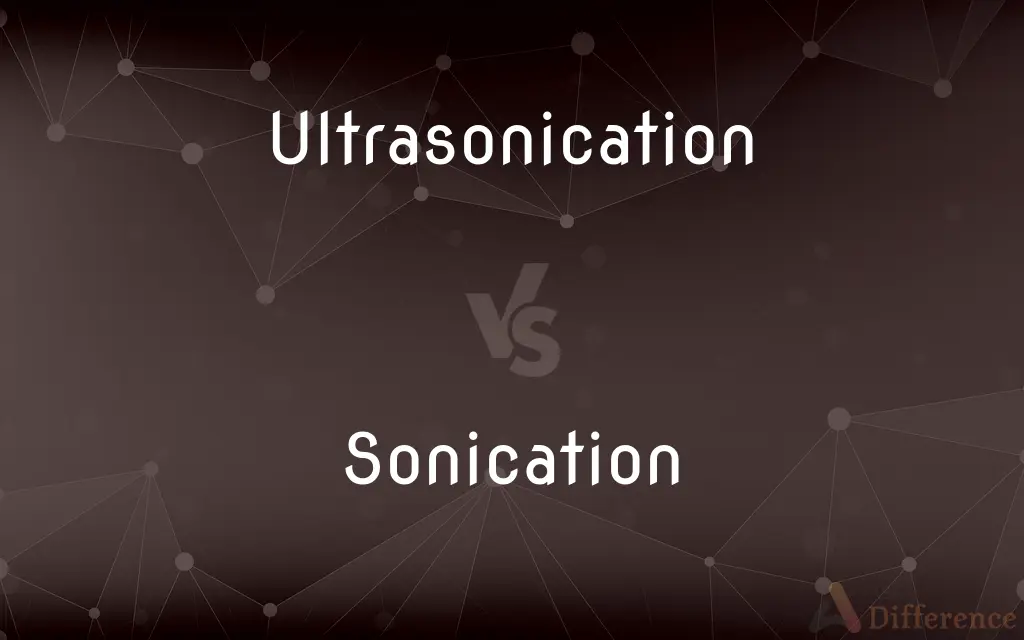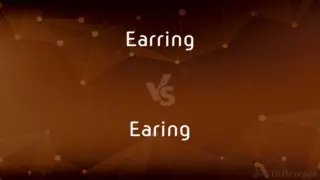Ultrasonication vs. Sonication — What's the Difference?
By Urooj Arif & Fiza Rafique — Updated on March 25, 2024
Ultrasonication employs ultrasonic frequencies (>20 kHz) for applications like cleaning or disrupting cells, emphasizing high-intensity sound waves. Sonication refers to general use of sound waves, not limited to ultrasonic range, for similar purposes.

Difference Between Ultrasonication and Sonication
Table of Contents
ADVERTISEMENT
Key Differences
Ultrasonication is a specific type of sonication that utilizes high-frequency sound waves, typically above 20 kHz, to induce effects such as cleaning surfaces, dispersing particles, or disrupting cell membranes in biological samples. Sonication, on the other hand, encompasses the use of sound waves across a broader range of frequencies to achieve similar physical and chemical effects in various applications.
One key difference lies in the intensity and energy of the sound waves used. Ultrasonication typically involves higher energy levels to generate powerful cavitation effects, making it suitable for applications requiring significant energy input, such as disrupting tough biological tissues or cleaning intricate parts. Sonication, with its broader frequency range, can be tailored to gentler applications, such as simple mixing or dissolving substances, where excessive energy might be detrimental.
In practical applications, ultrasonication is often preferred for its efficiency and effectiveness in processes like cell lysis, nanoparticle dispersion, and the removal of contaminants from surfaces. Sonication's versatility, however, allows it to be used in a wider variety of contexts, including those where lower energy inputs are sufficient or desired.
Despite these differences, both ultrasonication and sonication share the underlying principle of using sound waves to induce mechanical vibrations in a medium. The choice between them depends on the specific requirements of the application, including the desired intensity of the effect and the sensitivity of the materials involved.
Comparison Chart
Frequency Range
Typically >20 kHz
Includes both ultrasonic and lower frequencies
ADVERTISEMENT
Key Applications
Cell disruption, surface cleaning, nanoparticle dispersion
Mixing, dissolving, cleaning, extraction
Cavitation Intensity
High, due to ultrasonic frequencies
Variable, depending on frequency
Energy Level
High, for intense applications
Ranges from low to high, tailored to the application
Suitable Materials
Tough tissues, intricate parts
A broader range including sensitive samples
Compare with Definitions
Ultrasonication
Often used in scientific research for cell lysis or nanoparticle dispersion.
Nanoparticles were uniformly dispersed in the solution using ultrasonication.
Sonication
Versatile in application, suitable for both gentle and intense processes.
The delicate samples were prepared using mild sonication.
Ultrasonication
A process using ultrasonic frequencies to induce cavitation for cleaning or disrupting materials.
Ultrasonication was used to clean the intricate jewelry pieces.
Sonication
Can involve a range of sound frequencies, not limited to the ultrasonic.
Low-frequency sonication was used for the gentle mixing of the reagents.
Ultrasonication
Can achieve deep cleaning by generating powerful cavitation effects.
The lab equipment was thoroughly cleaned through ultrasonication.
Sonication
The use of sound waves to induce effects like mixing or cleaning in a sample.
Sonication helped dissolve the powder completely in the solution.
Ultrasonication
Suitable for applications requiring significant energy input.
Ultrasonication facilitated the extraction of compounds from the plant material.
Sonication
Often used in labs for processes like extraction or solubilization.
The active ingredients were extracted from the herbs through sonication.
Ultrasonication
Primarily involves frequencies above 20 kHz for high-intensity applications.
Ultrasonication effectively disrupted the cell membranes for the experiment.
Sonication
A broader term encompassing the use of sound waves for various effects.
Sonication was chosen as the method to clean the fragile artifacts.
Ultrasonication
Sonication using ultrasound
Sonication
Sonication is the act of applying sound energy to agitate particles in a sample, for various purposes such as the extraction of multiple compounds from plants, microalgae and seaweeds. Ultrasonic frequencies (>20 kHz) are usually used, leading to the process also being known as ultrasonication or ultra-sonication.In the laboratory, it is usually applied using an ultrasonic bath or an ultrasonic probe, colloquially known as a sonicator.
Sonication
The process of disrupting or homogenizing something, usually a chemical solution or biological medium, with sound waves.
Common Curiosities
Can sonication be used for cleaning?
Yes, sonication can be used for cleaning, leveraging the mechanical vibrations of sound waves to remove contaminants.
Why is ultrasonication preferred for cell disruption?
Ultrasonication is preferred for cell disruption due to its high-energy cavitation effects, which efficiently break down cell membranes.
What is ultrasonication?
Ultrasonication refers to the use of ultrasonic sound waves (typically above 20 kHz) to induce effects like cleaning, dispersing, or disrupting materials through cavitation.
Can ultrasonication speed up chemical reactions?
Yes, ultrasonication can speed up chemical reactions by improving mass transfer and generating localized high temperatures and pressures.
How do the effects of sonication vary with frequency?
Effects vary significantly; lower frequencies may result in gentle mixing or stirring, while higher ultrasonic frequencies can cause intense cavitation suitable for disruption or cleaning.
What are the main benefits of using sonication in laboratory settings?
Sonication offers benefits like improved mixing, faster dissolution, and efficient cleaning, making it a versatile tool in various laboratory applications.
What industries benefit from ultrasonication?
Industries like pharmaceuticals, cosmetics, food processing, and materials science benefit from the precise and efficient processes enabled by ultrasonication.
How does sonication differ from ultrasonication?
Sonication refers to the general use of sound waves for various effects, not limited by frequency, whereas ultrasonication specifically uses ultrasonic frequencies for intense applications.
Is sonication safe for all types of samples?
Sonication's safety depends on the sample and the intensity of the process; lower frequencies can be suitable for delicate samples, while high-intensity ultrasonication may damage sensitive materials.
How does the energy level of sonication affect its application?
The energy level determines the intensity of the process; higher energy is used for tough materials, while lower energy suits delicate applications.
Can ultrasonication damage sensitive materials?
Yes, the intense energy of ultrasonication can damage sensitive materials if not carefully controlled.
What equipment is required for ultrasonication?
Ultrasonication requires specialized equipment capable of generating ultrasonic frequencies, such as ultrasonic probes or baths.
Can ultrasonication be used in food processing?
Yes, ultrasonication is used in food processing for purposes like emulsification, extraction, and preservation, benefiting from its efficiency and effectiveness.
Is there a difference in the equipment used for ultrasonication and sonication?
While both processes use similar types of equipment, ultrasonication equipment is specifically designed to generate higher frequencies suitable for intense applications.
How does the choice between sonication and ultrasonication impact experimental outcomes?
The choice affects outcomes by determining the intensity of treatment, with ultrasonication typically providing more aggressive action, which can be necessary or detrimental depending on the material and objective.
Share Your Discovery

Previous Comparison
Debark vs. Disembark
Next Comparison
Earring vs. EaringAuthor Spotlight
Written by
Urooj ArifUrooj is a skilled content writer at Ask Difference, known for her exceptional ability to simplify complex topics into engaging and informative content. With a passion for research and a flair for clear, concise writing, she consistently delivers articles that resonate with our diverse audience.
Co-written by
Fiza RafiqueFiza Rafique is a skilled content writer at AskDifference.com, where she meticulously refines and enhances written pieces. Drawing from her vast editorial expertise, Fiza ensures clarity, accuracy, and precision in every article. Passionate about language, she continually seeks to elevate the quality of content for readers worldwide.















































